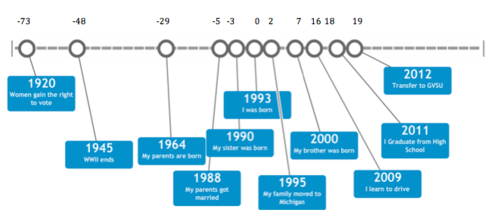This was a great was to give the students immediate feedback. Some students went through the whole quiz and then came up to have it corrected. Other students would do one question and then have us check it.
After awhile we would circle individual terms that were right. This was a great way for students to get to see exactly what they knew and didn't know.
I loved this because this was the last day before break so the students were a little antsy. This was a great way to get the kids up and moving around.
Here was the quiz they took:
Write each expression in simplest form.
1. h+6h
No one really had problems with this one.
2. 5c-3d-12c+d
This one gave a lot of kids problems. They would often get -17c+4d
They had trouble with keeping track of the signs. I think that in response to this Mr. Kuzee should really review adding and subtracting integers.
* a few of them were trying to combine c's and d's. To this Mr. Kuzee brought out the analogy that c's are like socks and d's are like apples. And so we cannot combine socks and apples so we can't combine c's and d's. I liked how he did this. (He also referred back to when the kids did algebra tiles but I think putting it into real life things made it easier for them to understand).
3. -y+9z-16y-25z
This question gave the students similar problems as #2
MEASUREMENT Write an expression in simplest form for the perimeter of each figure.
This was a great way to combine their previous talk about perimeter with today's lesson about simplifying expressions. The main issue that students had with this was combining -3 and 6 to get 9.
5. 2(2x-1)+(-3x+7)
6. (-5x+4)+(-9x-2)
7. (11x+2)+(-8x-2)
8. (-9x-10)+(-5x-4)
All of these problems brought up the same issue, of working with integers.
9. Find the sum of (x+3) and (-x-4)
With this question many students did not understand that finding the sum meant adding
10. GEOMETRY Write and simplify an expression to present the perimeter of the triangle shown.
Mr. Kuzee was really surprised by the results that this quiz brought up. Most of the students were not struggling with the idea of combining "like terms" but with working with positive and negative integers. He was frustrated because this is something that he said they did at the beginning of the year.
So while this "quiz" did not give him the results that he expected, it did show him exactly what he needed to focus on and review with the students.
As a whole I really like this method of assessment, it is low risk because the students are allowed to come up and get their work checked at any point. And it gives them immediate feedback. The students were able to see right away if what they thought was right was in fact right. While I know that students often have the answers to some of the questions in the backs of their books, this method creates better feedback.
The feedback is better in this situation because when the students are given just the answer a few things can happen:
(1) they could just copy the answers from the back and not try to actually do the work at all
(2) they could get the right answer by luck instead of actually having down the work right.
(3) they could get the wrong answer but not know how to change things so they can get the right answer.
The quiz by exhaustion does a good job of eliminating most of these options.
Also having us check their answer immediately also helps it so the students can have an immediate response. Too often students are given homework or a quiz and by the time they find out if they go the right answer they have forgot what they did in the first place.



